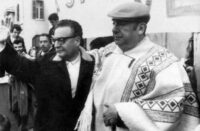One of Sergei Prokofiev’s most famous compositions is Peter and the Wolf (1936). Natalya Sats, then director of the Moscow Musical Theatre for Children, had commissioned this work to introduce children to some of the instruments of the orchestra, and to classical music.
Prokofiev had met Sats while taking his sons to her theatre in He wrote a draft for the piano in a few days, finishing the orchestration nine days later, on 24 April It was performed to great acclaim, with Sats narrating, at the Pioneer Palace in Moscow. Prokofiev later said: “In Russia today there is a great emphasis on the musical education of children. One of my orchestral pieces [Peter and the Wolf] was an experiment. Children get an impression of several instruments of the orchestra just by hearing the piece performed.”
Prokofiev himself wrote the story, which is narrated by a speaker. First, the narrator introduces the characters with their musical motifs. In the course of the story the narrator explains what is happening. If you know which instrument belongs to which animal, the music speaks for itself.
All the people and animals in the story are played on different instruments:
Peter is represented by strings (including violins, violas and cellos), with their sweet, clear sound. Their light, high sound describes Peter as a happy and outgoing boy.
The confident, forceful hunters are played by the timpani and trumpets, with the timpani and bass drumbeats enacting rifle shots.
The bird is characterised by the flute: fluttery, happy chirping.
The slightly nasal sound of the oboe suggests the quacking, waddling duck.
The soft, warm sound of the clarinet evokes the velvety, elegant and sneaky cat.
No instrument is better suited to the slow grandfather than the dark, low register of the bassoon.
The wolf is conjured up by three French horns. He is dangerous and lives in the forest; the French horn, with its large and deep sound, suggests this perfectly.
Peter, who lives with his grandfather on the edge of a forest, understands the language of the cat, the bird, and the duck. The animals are his friends. One day the wolf emerges from the forest and devours the duck in one gulp. Peter devises a plan to catch the wolf, with the help of the bird.
We hear about Peter’s love for animals, about grandfather’s worries, about birds arguing whether they should swim or fly, about the cat’s unsuccessful pursuit of the bird, about the arrival of the wicked wolf, and, finally, how the bird and Peter catch the wolf, and everybody’s triumphal procession to the zoo.
The story begins on a calm and sunny morning. Peter’s strings play a happy tune; there are upward leaps in the melody, the flutes (bird) trill. When the birds argue, the mood becomes louder and discordant, with a back and forth between the instruments. As the wolf appears, chases and catches the duck, the mood conveyed by the music becomes alarming, threatening; the rhythm becomes faster and the oboe (duck) climbs in pitch with anxiety; discord ends in loud alarm.
Following this crisis, Peter and the bird attempt to catch the wolf with a lasso. The mood becomes anxious, a sense of breath being held as the music descends in pitch. Soft strings pause before the brass blares loudly. When the wolf is caught it is taken to the zoo in a jubilant procession with all involved. The mood is happy, and we hear trills, and fast arpeggios on clarinet, strings, and flutes, and there is a sense of happy skipping.
This musical fairy tale is an example of socialist realism. It features a “group of heroes,” not an individual one. Peter and the bird need one another to defeat the wolf. It is profoundly humanist: the adversary, the wolf, is not killed but put out of dangerous action and made available for educational purposes. There is an optimistic ending, in that the wicked wolf is defeated without bloodshed but also that the duck seems to have survived in the wolf’s stomach. And all this is expressed in the music: the group hero idea while the wolf is captured, as well as in the tutti of all the themes in the procession to the zoo, and the duck’s survival in sounding a very muted duck theme at the end—from the wolf’s belly, as it were.
It is a happy ending indeed, celebrating friendship, courage and co-operation in the defeat of danger and evil.
Even if the haunting melodies seem simple at first glance, they are not. The musical story is vividly and beautifully interwoven, in word and sound, action and musical gesture, including many masterful tone paintings. Listeners learn that music can tell its own story, once you understand that themes can represent characters that are repeated initially until you get to know them. They then develop into variations. They can interact, they can struggle, they can harmonise.
This wonderful introduction to understanding classical music is not didactic, and it is not just for children. It is thoroughly memorable and enjoyable.
Peter and the Wolf, Sergei Prokofiev’s best-known composition to this day, can be seen on line.






